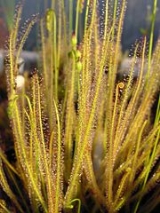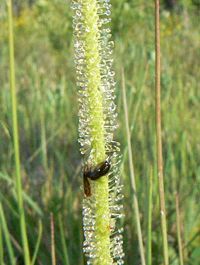
Drosera filiformis
Encyclopedia

Carnivorous plant
Carnivorous plants are plants that derive some or most of their nutrients from trapping and consuming animals or protozoans, typically insects and other arthropods. Carnivorous plants appear adapted to grow in places where the soil is thin or poor in nutrients, especially nitrogen, such as acidic...
, rosette
Rosette (botany)
In botany, a rosette is a circular arrangement of leaves, with all the leaves at a single height.Though rosettes usually sit near the soil, their structure is an example of a modified stem.-Function:...
forming species of perennial
Perennial plant
A perennial plant or simply perennial is a plant that lives for more than two years. The term is often used to differentiate a plant from shorter lived annuals and biennials. The term is sometimes misused by commercial gardeners or horticulturalists to describe only herbaceous perennials...
herb
Herbaceous
A herbaceous plant is a plant that has leaves and stems that die down at the end of the growing season to the soil level. They have no persistent woody stem above ground...
. A species of sundew, it is unusual within its genus in that the long, erect, filiform (thread-like) leaves of this plant unroll in spirals - an arrangement similar to the circinate vernation seen in Fern
Fern
A fern is any one of a group of about 12,000 species of plants belonging to the botanical group known as Pteridophyta. Unlike mosses, they have xylem and phloem . They have stems, leaves, and roots like other vascular plants...
s.
Distribution and habitat
D. filiformis occurs naturally in both CanadaCanada
Canada is a North American country consisting of ten provinces and three territories. Located in the northern part of the continent, it extends from the Atlantic Ocean in the east to the Pacific Ocean in the west, and northward into the Arctic Ocean...
and the United States
United States
The United States of America is a federal constitutional republic comprising fifty states and a federal district...
; its natural range extends down the eastern seaboard of North America
North America
North America is a continent wholly within the Northern Hemisphere and almost wholly within the Western Hemisphere. It is also considered a northern subcontinent of the Americas...
from south western Nova Scotia
Nova Scotia
Nova Scotia is one of Canada's three Maritime provinces and is the most populous province in Atlantic Canada. The name of the province is Latin for "New Scotland," but "Nova Scotia" is the recognized, English-language name of the province. The provincial capital is Halifax. Nova Scotia is the...
in the north down through New England
New England
New England is a region in the northeastern corner of the United States consisting of the six states of Maine, New Hampshire, Vermont, Massachusetts, Rhode Island, and Connecticut...
to Florida
Florida
Florida is a state in the southeastern United States, located on the nation's Atlantic and Gulf coasts. It is bordered to the west by the Gulf of Mexico, to the north by Alabama and Georgia and to the east by the Atlantic Ocean. With a population of 18,801,310 as measured by the 2010 census, it...
and Louisiana
Louisiana
Louisiana is a state located in the southern region of the United States of America. Its capital is Baton Rouge and largest city is New Orleans. Louisiana is the only state in the U.S. with political subdivisions termed parishes, which are local governments equivalent to counties...
in the south.
Cultivation
D. filiformis is frequently cultivated, with several registered cultivars, such as D. filiformis var. filiformis (also known as D. filiformis typical), D. filiformis var. tracyi (a taller plant, with clear, instead of red, tentacles), D. filiformis × 'California Sunset' (a hybrid between D. filiformis var. filiformis and D. filiformis var. tracyi), and D. filiformis × 'Florida All Red' (a variety that becomes red in full sun, and does not require hibernation in winter). All of these cultivars are grown with similar conditions as most other Drosera species: mineral-poor soil and distilled, reverse osmosisReverse osmosis
Reverse osmosis is a membrane technical filtration method that removes many types of large molecules and ions from solutions by applying pressure to the solution when it is on one side of a selective membrane. The result is that the solute is retained on the pressurized side of the membrane and...
, or collected rain water. All types of D. filiformis other than 'Florida All Red' require a winter dormancy for long term survival, forming hibernacula
Hibernaculum (botany)
Hibernaculum is the term often applied to a winter bud of certain aquatic plants, such as the bladderworts . The buds are heavier than water, and, being developed at the approach of cold weather, they become detached, sink to the bottom of the pond, and thus survive the winter...
in the winter.
Infraspecific taxa
- Drosera filiformis f. tracyi (Macf. ex Diels) Macf. (1914)
- Drosera filiformis var. tracyi (Macf. ex Diels) Diels (1906)
- Drosera filiformis var. typica Winne (1944) nom.illeg.

